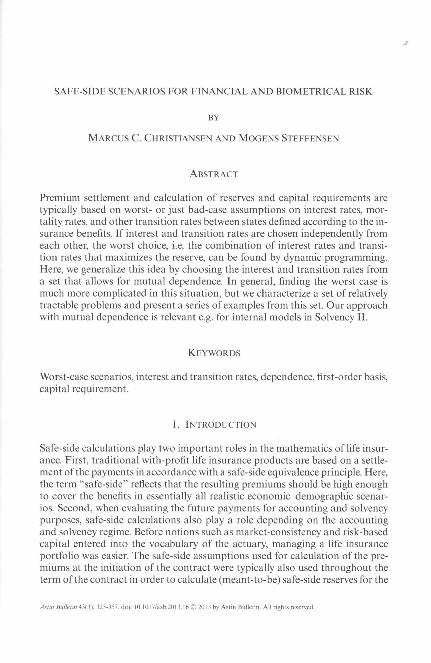Safe-side scenarios for financial and biometrical risk

Contenido multimedia no disponible por derechos de autor o por acceso restringido. Contacte con la institución para más información.
| Tag | 1 | 2 | Valor |
|---|---|---|---|
| LDR | 00000cab a2200000 4500 | ||
| 001 | MAP20130038490 | ||
| 003 | MAP | ||
| 005 | 20131120175251.0 | ||
| 008 | 131119e20130902esp|||p |0|||b|eng d | ||
| 040 | $aMAP$bspa$dMAP | ||
| 084 | $a6 | ||
| 100 | 1 | $0MAPA20130002446$aChristiansen, Marcus C. | |
| 245 | 1 | 0 | $aSafe-side scenarios for financial and biometrical risk$cMarcus C. Christiansen, Mogens Steffensen |
| 520 | $aPremium settlement and calculation of reserves and capital requirements are typically based on worst- or just bad-case assumptions on interest rates, mortality rates, and other transition rates between states defined according to the insurance benefits. If interest and transition rates are chosen independently from each other, the worst choice, i.e. the combination of interest rates and transition rates that maximizes the reserve, can be found by dynamic programming. Here, we generalize this idea by choosing the interest and transition rates from a set that allows for mutual dependence. In general, finding the worst case is much more complicated in this situation, but we characterize a set of relatively tractable problems and present a series of examples from this set. Our approach with mutual dependence is relevant e.g. for internal models in Solvency II. | ||
| 773 | 0 | $wMAP20077000420$tAstin bulletin$dBelgium : ASTIN and AFIR Sections of the International Actuarial Association$x0515-0361$g02/09/2013 Volumen 43 Número 3 - septiembre 2013 |

